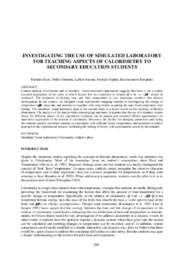Investigating the use of simulated laboratory for teaching aspects of calorimetry to secondary education students

View/Open
Date
2005Author
Petridou, Eleni
Psillos, Dimitris
Lefkos, Ioannis
Fourlari, Sophia
Hatzikraniotis, Euripides
Metadata
Show full item recordAbstract
Content analysis of textbooks and of research - based innovative approaches suggests that there is not a widely accepted negotiation of the order in which factors that are expressed in relation Q = m c should be examined. The treatment of heating time and final temperature is also important variables that deserve investigation. In this context, we designed visual experiments engaging students in investigating the change of temperature (), mass (m), and material (c) together with using bodies acquiring the same final temperature after heating. The simulated visual laboratory used in the present study is a micro-world for the teaching of thermal phenomena. The analysis of the data provided encouraging outcomes. It appears that the use of a dynamic system where the different phases of the experiment evolution can be paused and restarted offered opportunities for innovative negotiation of the relation of calorimetry. Moreover, the facility for changing parameters and seeing the readouts quickly permitted students to experiment with different initial temperatures and promoted a holistic approach to the experimental process, facilitating the linking of theory with experimental results by the students.